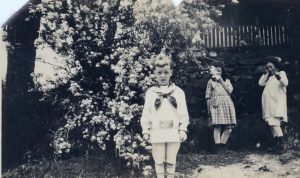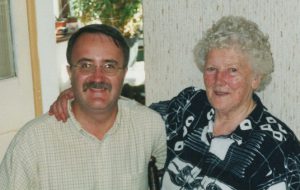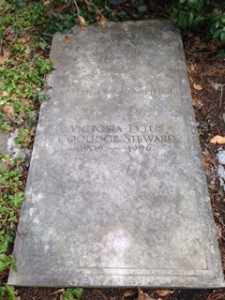Recently, while leafing through an old album of my father’s family, I came across two large adjacent cabinet card photos of a couple I didn’t know labeled “Hattie Gordon” and “Lawrence Gordon.” There is only one Hattie Gordon (Harriett Frances Gordon Cony, 1849–1922) in my family tree, and this lady is not she; there is no Lawrence Gordon, either. Had I missed some cousins? An aunt or uncle, long-lost or abandoned? Maybe they were just good friends of the family. The questions began circling. No one I asked recognized these people or their names. Of course, I had to figure out who they were and why they were in this album (organizing materials can wait, right?). Continue reading Finding Hattie
Tag Archives: Photographs
Also known as

Many of the vernacular photos I’ve bought in the last few months have no information about the sitter – sometimes the subject is identified by a nickname, such as “Stinky.” I recently bought an intriguing image of a man (apparently) dancing, and I was delighted to find his full name and date of birth on the reverse: Cecil Calvert Taliaferro, born 24 January 1922.
A glance at Ancestry.com for Cecil suggested a complex identity: he appears in the Social Security Applications and Claims Index as Cecil Calvert Taliaferro (born 24 January 1923), also known as Chet Tolliver, also known as Chet Toliver. It is as Cecil Taliaferro that he is buried at Melvin Cemetery in Melvin, McCulloch County, Texas, but Ancestry links Cecil and Chet at the Social Security Death Index. Continue reading Also known as
A sense of place

The town of Lee, Massachusetts holds special meaning to my maternal side of the family. My grandmother, Hope Elizabeth Dunn, was the daughter of William Jordan Dunn and Helen Veronica Maloney. She was born in New Bedford, Massachusetts in 1911, the oldest of three children. Her siblings, Helen and William Dunn, were also born in Bristol County, Massachusetts during the 1910s.
When their father died in 1918, Helen Veronica Dunn was left to raise three young children on her own. Continue reading A sense of place
Deadheading

My grandmother Katheryn Ogle Record (1914–1993) was a dead head. No, surely not that kind of dead head, but one who collected those lifetime addenda we all hope someone will afford each of us someday. We call them obituaries, and at a very early age my grandmother began collecting them. In some ways my grandmother was the consummate family historian. While I never saw her record births or deaths in a family Bible, or transcribe items from a census, she did keep records – and actually very good ones. Continue reading Deadheading
Poppa’s wallet
 My grandfather (Walter Robert “Bob” Heisinger, a.k.a. Poppa) was notorious for carrying around a gigantic wallet bursting at the seams with photographs, business cards, and other little mementos he picked up over the years. He would often pull bits and pieces out at social gatherings as props to his stories and jokes. I remember harassing him as a teenager that the thickness of the wallet was contributing to his hip problems and I made a box for him to store some of its contents, though I am sure the box remained empty for the rest of his life. Continue reading Poppa’s wallet
My grandfather (Walter Robert “Bob” Heisinger, a.k.a. Poppa) was notorious for carrying around a gigantic wallet bursting at the seams with photographs, business cards, and other little mementos he picked up over the years. He would often pull bits and pieces out at social gatherings as props to his stories and jokes. I remember harassing him as a teenager that the thickness of the wallet was contributing to his hip problems and I made a box for him to store some of its contents, though I am sure the box remained empty for the rest of his life. Continue reading Poppa’s wallet
Serendipity

Inspired by the Persian fairy tale The Three Princes of Serendip, Horace Walpole gave us the word serendipity. The following three tales shine among my past treasures as extraordinary encounters that would have been lost to history had I not been in the right place at the right time.
In the fall of 1983, I drove to West Wareham, Massachusetts on a mission to find my great-grandfather’s grave. As I searched in vain for the stone, an elderly man who lived across the road from the cemetery spied my Vermont license plate and asked for whom I was searching. “Millard Morse, father of Emory,” I said. He retorted, “Who ARE you?” Continue reading Serendipity
ICYMI: Family plots: Part Two
[Author’s note: This blog post originally appeared in Vita Brevis on 19 October 2015.]
 Riffing on something Chris Child wrote about collecting photos of family members in July, I thought I might do something similar with information about family burial plots. Such an exercise leans heavily on Findagrave.com (where some of the images may be found), although in my case I also have the notes compiled by my great-aunt Margaret Steward in 1966 as a resource for my research.
Riffing on something Chris Child wrote about collecting photos of family members in July, I thought I might do something similar with information about family burial plots. Such an exercise leans heavily on Findagrave.com (where some of the images may be found), although in my case I also have the notes compiled by my great-aunt Margaret Steward in 1966 as a resource for my research.
My grandparents are easy: my father’s parents (and stepmother) are buried at Hamilton Cemetery in Massachusetts, while my mother’s parents (and stepmother) are buried at Arlington National Cemetery in Virginia. I was present for my paternal grandfather’s memorial service in 1991, my maternal grandfather’s burial in 1994, and for my paternal step-grandmother’s memorial service in 1996. Continue reading ICYMI: Family plots: Part Two
A block buster
Most of us will remember the childhood Alphabet Song used to teach children their letters (hum along if you’d like): “A-B-C-D-E-F-G… Now I’ve learned my ABCs, tell me what you think of me.” Vita Brevis has given a new variation on this “alpha-tradition.”
In my post “If This House Could Talk,” I mentioned my grandfather Rex Church (1883–1956) and his childhood handmade wooden alphabet blocks. The photo I provided showed only the four blocks representing the surname initials of the four families who have lived in My Old House since its construction in 1789. Continue reading A block buster
A family register
 Over the holidays, my mother gave me the very nice present of a family register that began with my great-great-great-grandparents – Robert and Emma (Russell) Thompson of Industry, Maine. This framed register used to hang on a wall at my grandparents’ home in Kansas, and I had taken notes from it when I got interested in family history. My mother got it after her mother’s death in 2008, and she decided I was the best relative to receive it. This register was produced by D. Needham, 12 Exchange St, Buffalo, and years ago I recognized a copy of the same style register for sale in our own bookstore. Continue reading A family register
Over the holidays, my mother gave me the very nice present of a family register that began with my great-great-great-grandparents – Robert and Emma (Russell) Thompson of Industry, Maine. This framed register used to hang on a wall at my grandparents’ home in Kansas, and I had taken notes from it when I got interested in family history. My mother got it after her mother’s death in 2008, and she decided I was the best relative to receive it. This register was produced by D. Needham, 12 Exchange St, Buffalo, and years ago I recognized a copy of the same style register for sale in our own bookstore. Continue reading A family register
Ex libris

When I catalog new books received by the NEHGS library, my normal focus is, naturally, on the contents of the books themselves: the families and places described, the authors, the titles and publication information, and so on. But every now and then, the books we receive contain little “surprises” that go beyond the published words on the page. Over the years, we have found all kinds of objects left in books, from hand-drawn family trees to photographs and calling cards. Some of these items were clearly meant to supplement the books they were left in, and have definite genealogical import; others are only tangentially related to the book’s content. Still others are complete mysteries: we don’t know why they were left in the book, or if they were even left there on purpose. Continue reading Ex libris



